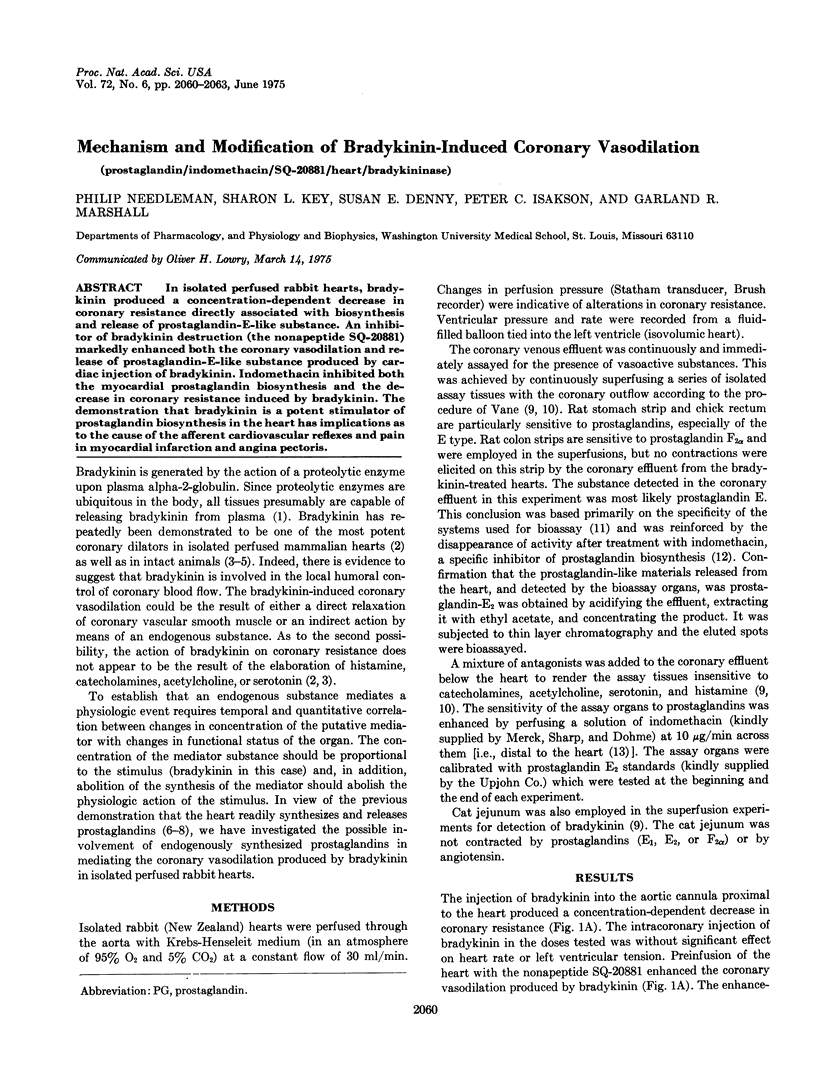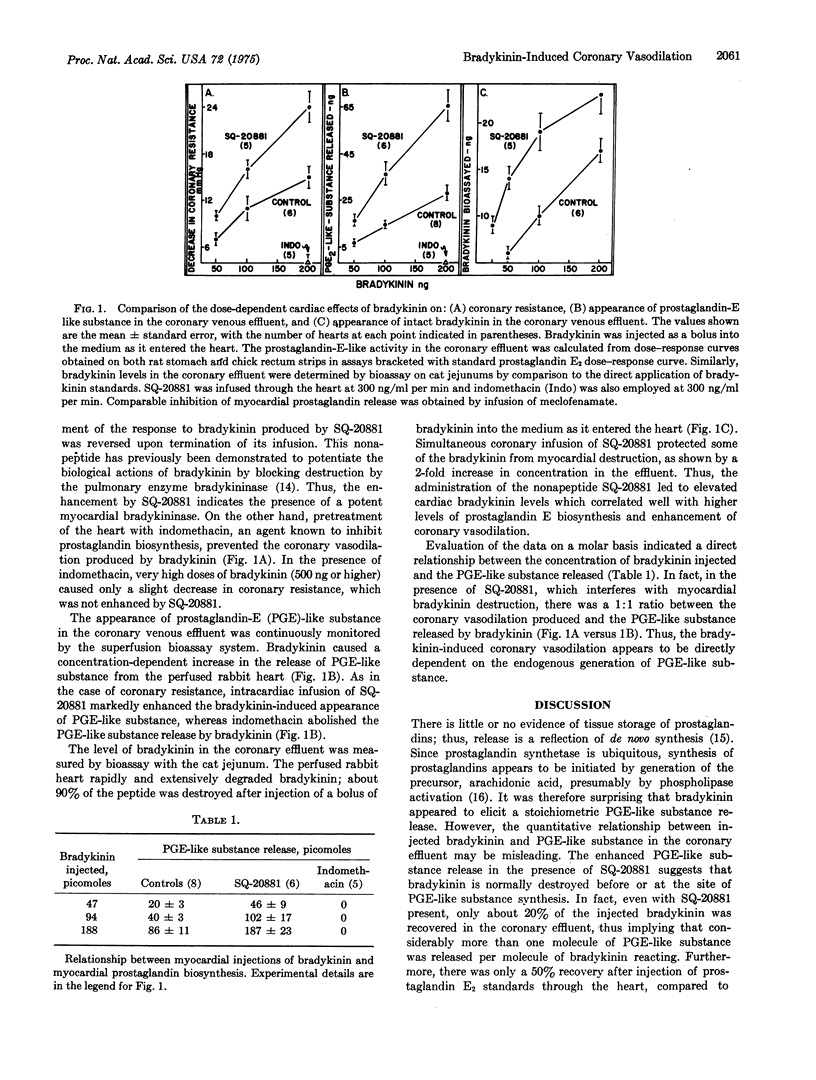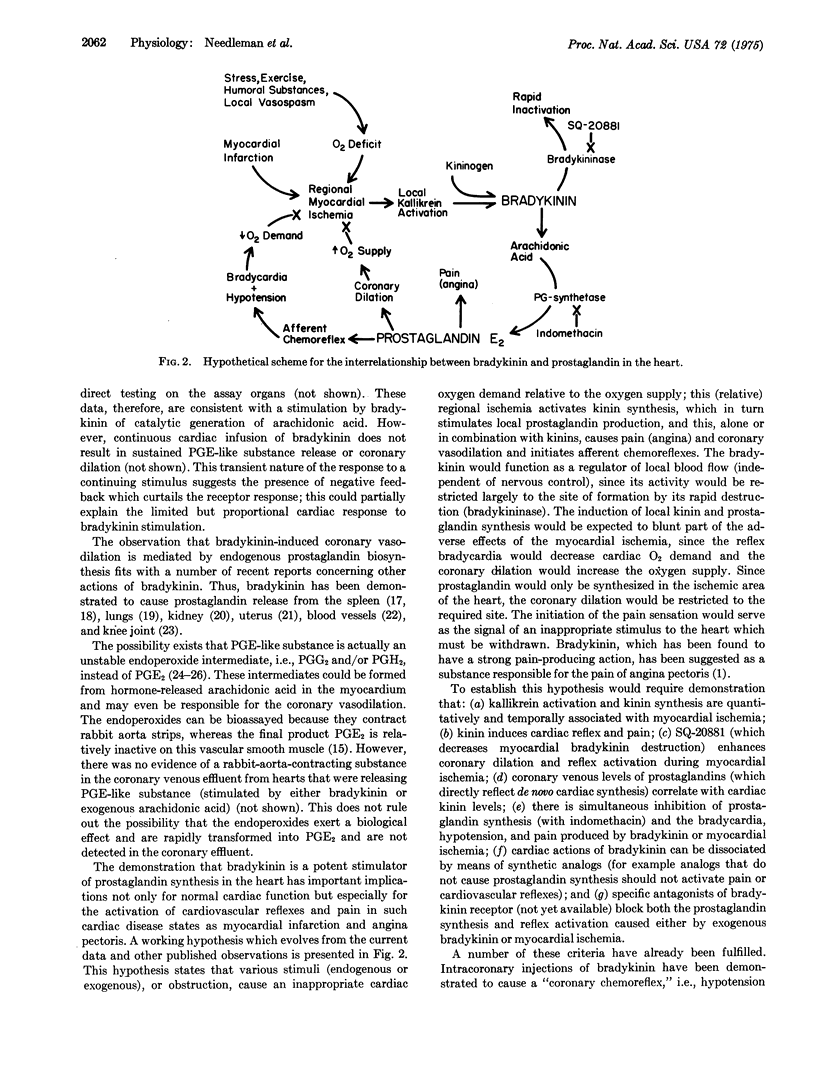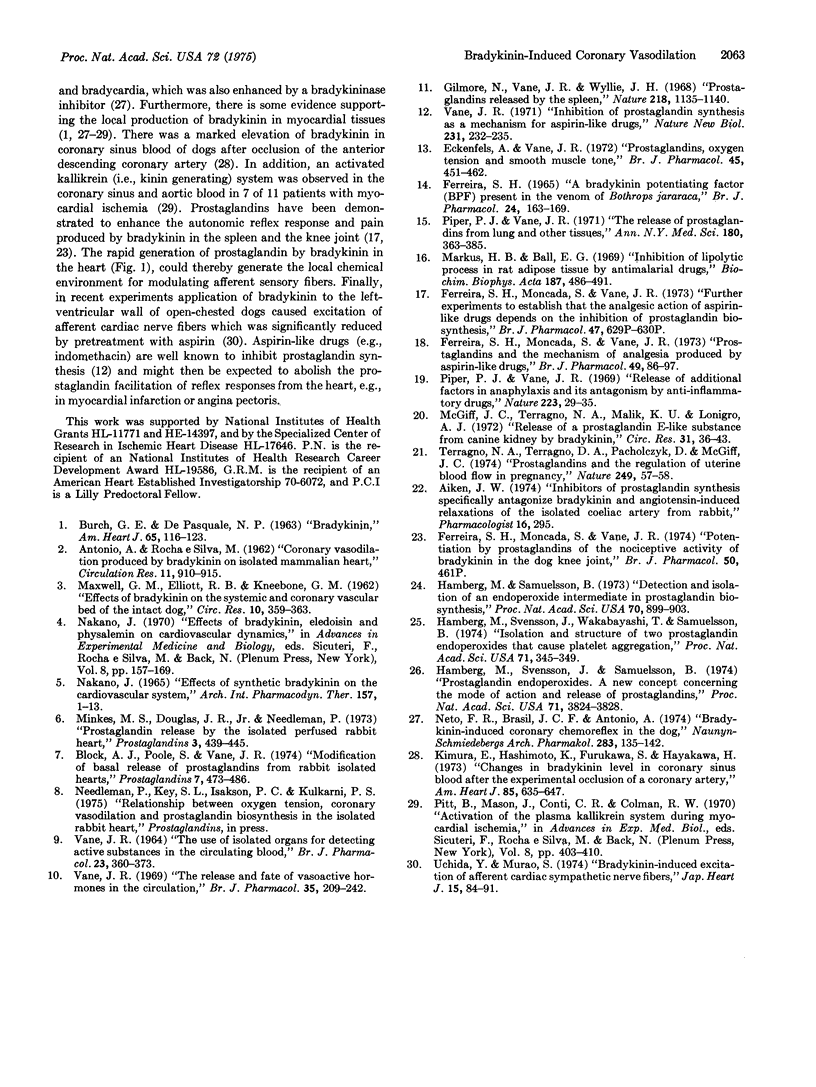Abstract
In isolated perfused rabbit hearts, bradykinin produced a concentration-dependent decrease in coronary resistance directly associated with biosynthesis and release of prostaglandin-E-like substance. An inhibitor of bradykinin destruction (the nonapeptide SQ-20881) markedly enhanced both the coronary vasodilation and release of prostaglandin-E-like substance produced by cardiac injection of bradykinin. Indomethacin inhibited both the myocardial prostaglandin biosynthesis and the decrease in coronary resistance induced by bradykinin. The demonstration that bradykinin is a potent stimulator of prostaglandin biosynthesis in the heart has implications as to the cause of the afferent cardiovascular reflexes and pain in myocardial infarction and angina pectoris.
Full text
PDF



Selected References
These references are in PubMed. This may not be the complete list of references from this article.
- ANTONIO A., ROCHA E SILVA M. Coronary vasodilation produced by bradykinin on isolated mammalian heart. Circ Res. 1962 Dec;11:910–915. doi: 10.1161/01.res.11.6.910. [DOI] [PubMed] [Google Scholar]
- BURCH G. E., DEPASQUALE N. P. Bradykinin. Am Heart J. 1963 Jan;65:116–123. doi: 10.1016/0002-8703(63)90221-7. [DOI] [PubMed] [Google Scholar]
- Block A. J., Poole S., Vane J. R. Modification of basal release of prostaglandins from rabbit isolated hearts. Prostaglandins. 1974 Sep 25;7(6):473–486. doi: 10.1016/0090-6980(74)90092-6. [DOI] [PubMed] [Google Scholar]
- Eckenfels A., Vane J. R. Prostaglandins, oxygen tension and smooth muscle tone. Br J Pharmacol. 1972 Jul;45(3):451–462. doi: 10.1111/j.1476-5381.1972.tb08101.x. [DOI] [PMC free article] [PubMed] [Google Scholar]
- FERREIRA S. H. A BRADYKININ-POTENTIATING FACTOR (BPF) PRESENT IN THE VENOM OF BOTHROPS JARARCA. Br J Pharmacol Chemother. 1965 Feb;24:163–169. doi: 10.1111/j.1476-5381.1965.tb02091.x. [DOI] [PMC free article] [PubMed] [Google Scholar]
- Ferreira S. H., Moncada S., Vane J. R. Further experiments to establish that the analgesic action of aspirin-like drugs depends on the inhibition of prostaglandin biosynthesis. Br J Pharmacol. 1973 Mar;47(3):629P–630P. [PMC free article] [PubMed] [Google Scholar]
- Ferreira S. H., Moncada S., Vane J. R. Proceedings: Potentiation by prostaglandins of the nociceptive activity of bradykinin in the dog knee joint. Br J Pharmacol. 1974 Mar;50(3):461P–461P. [PMC free article] [PubMed] [Google Scholar]
- Ferreira S. H., Moncada S., Vane J. R. Prostaglandins and the mechanism of analgesia produced by aspirin-like drugs. Br J Pharmacol. 1973 Sep;49(1):86–97. doi: 10.1111/j.1476-5381.1973.tb08270.x. [DOI] [PMC free article] [PubMed] [Google Scholar]
- Gilmore N., Vane J. R., Wyllie J. H. Prostaglandins released by the spleen. Nature. 1968 Jun 22;218(5147):1135–1140. doi: 10.1038/2181135a0. [DOI] [PubMed] [Google Scholar]
- Hamberg M., Samuelsson B. Detection and isolation of an endoperoxide intermediate in prostaglandin biosynthesis. Proc Natl Acad Sci U S A. 1973 Mar;70(3):899–903. doi: 10.1073/pnas.70.3.899. [DOI] [PMC free article] [PubMed] [Google Scholar]
- Hamberg M., Svensson J., Samuelsson B. Prostaglandin endoperoxides. A new concept concerning the mode of action and release of prostaglandins. Proc Natl Acad Sci U S A. 1974 Oct;71(10):3824–3828. doi: 10.1073/pnas.71.10.3824. [DOI] [PMC free article] [PubMed] [Google Scholar]
- Hamberg M., Svensson J., Wakabayashi T., Samuelsson B. Isolation and structure of two prostaglandin endoperoxides that cause platelet aggregation. Proc Natl Acad Sci U S A. 1974 Feb;71(2):345–349. doi: 10.1073/pnas.71.2.345. [DOI] [PMC free article] [PubMed] [Google Scholar]
- Kimura E., Hashimoto K., Furukawa S., Hayakawa H. Changes in bradykinin level in coronary sinus blood after the experimental occlusion of a coronary artery. Am Heart J. 1973 May;85(5):635–647. doi: 10.1016/0002-8703(73)90169-5. [DOI] [PubMed] [Google Scholar]
- MAXWELL G. M., ELLIOTT R. B., KNEEBONE G. M. Effects of bradykinin on the systemic and coronary vascular bed of the intact dog. Circ Res. 1962 Mar;10:359–363. doi: 10.1161/01.res.10.3.359. [DOI] [PubMed] [Google Scholar]
- Markus H. B., Ball E. G. Inhibition of lipolytic processes in rat adipose tissue by antimalaria drugs. Biochim Biophys Acta. 1969 Dec 17;187(4):486–491. doi: 10.1016/0005-2760(69)90045-9. [DOI] [PubMed] [Google Scholar]
- McGiff J. C., Terragno N. A., Malik K. U., Lonigro A. J. Release of a prostaglandin E-like substance from canine kidney by bradykinin. Circ Res. 1972 Jul;31(1):36–43. doi: 10.1161/01.res.31.1.36. [DOI] [PubMed] [Google Scholar]
- Minkes M. S., Douglas J. R., Jr, Needleman P. Prostaglandin release by the isolated perfused rabbit heart. Prostaglandins. 1973 Apr;3(4):439–445. doi: 10.1016/0090-6980(73)90151-2. [DOI] [PubMed] [Google Scholar]
- Nakano J. Effects of synthetic bradykinin on the cardiovascular system. Arch Int Pharmacodyn Ther. 1965 Sep;157(1):1–13. [PubMed] [Google Scholar]
- Neto F. R., Brasil J. C., Antonio A. Bradykinin-induced coronary chemoreflex in the dog. Naunyn Schmiedebergs Arch Pharmacol. 1974;283(2):135–142. doi: 10.1007/BF00501140. [DOI] [PubMed] [Google Scholar]
- Piper P. J., Vane J. R. Release of additional factors in anaphylaxis and its antagonism by anti-inflammatory drugs. Nature. 1969 Jul 5;223(5201):29–35. doi: 10.1038/223029a0. [DOI] [PubMed] [Google Scholar]
- Piper P., Vane J. The release of prostaglandins from lung and other tissues. Ann N Y Acad Sci. 1971 Apr 30;180:363–385. doi: 10.1111/j.1749-6632.1971.tb53205.x. [DOI] [PubMed] [Google Scholar]
- Terragno N. A., Terragno D. A., Pacholczyk D., McGiff J. C. Prostaglandins and the regulation of uterine blood flow in pregnancy. Nature. 1974 May 3;249(452):57–58. doi: 10.1038/249057a0. [DOI] [PubMed] [Google Scholar]
- Uchida Y., Murao S. Bradykinin-induced excitation of afferent cardiac sympathetic nerve fibers. Jpn Heart J. 1974 Jan;15(1):84–91. doi: 10.1536/ihj.15.84. [DOI] [PubMed] [Google Scholar]
- VANE J. R. THE USE OF ISOLATED ORGANS FOR DETECTING ACTIVE SUBSTANCES IN THE CIRCULATING BLOOD. Br J Pharmacol Chemother. 1964 Oct;23:360–373. doi: 10.1111/j.1476-5381.1964.tb01592.x. [DOI] [PMC free article] [PubMed] [Google Scholar]
- Vane J. R. Inhibition of prostaglandin synthesis as a mechanism of action for aspirin-like drugs. Nat New Biol. 1971 Jun 23;231(25):232–235. doi: 10.1038/newbio231232a0. [DOI] [PubMed] [Google Scholar]
- Vane J. R. The release and fate of vaso-active hormones in the circulation. Br J Pharmacol. 1969 Feb;35(2):209–242. doi: 10.1111/j.1476-5381.1969.tb07982.x. [DOI] [PMC free article] [PubMed] [Google Scholar]


